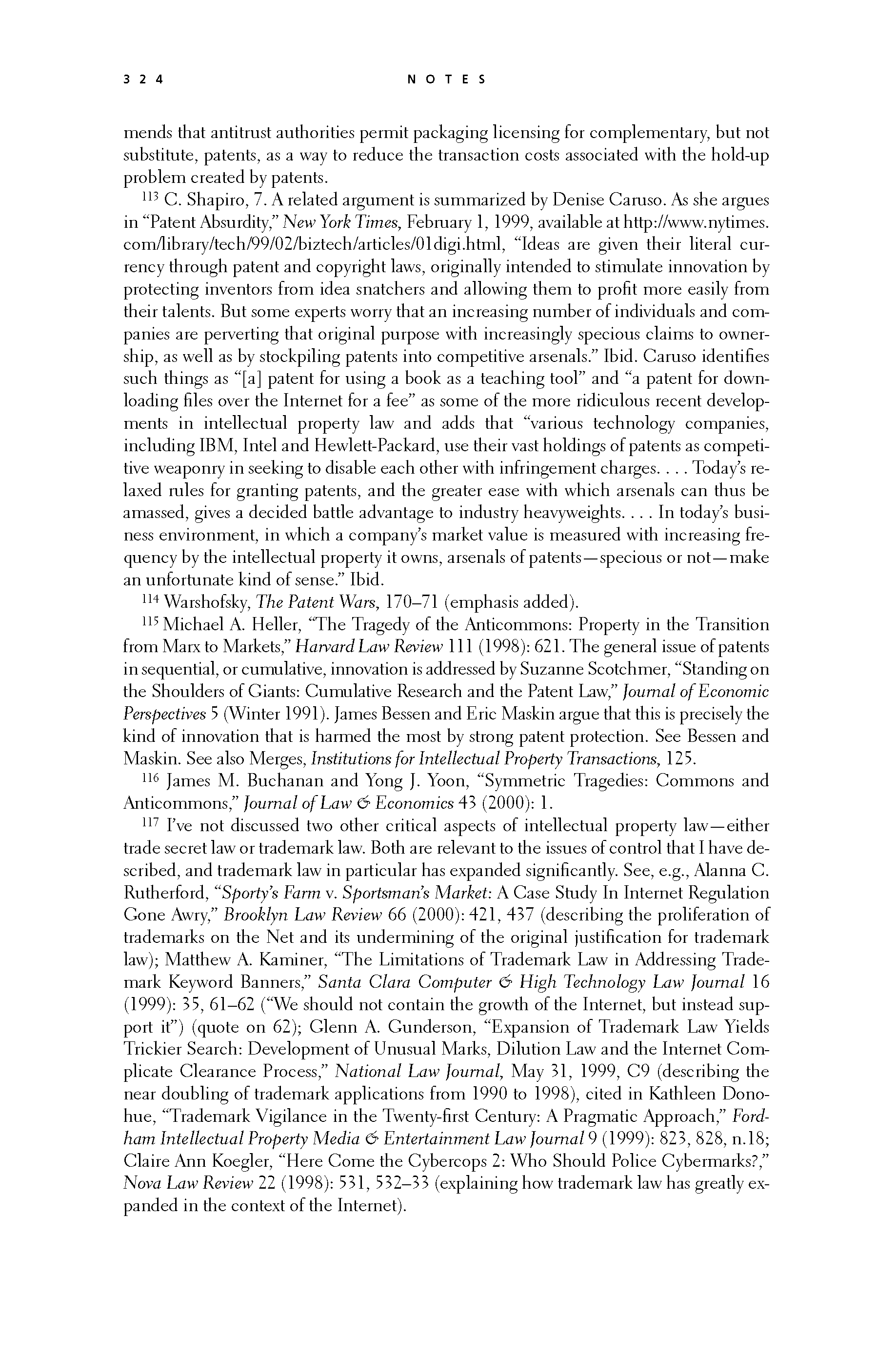 p323 _
-chap- _
toc-1 _
p324w _
toc-2 _
+chap+ _
p325
p323 _
-chap- _
toc-1 _
p324w _
toc-2 _
+chap+ _
p325
mends that antitrust authorities permit packaging licensing for complementary, but not
substitute, patents, as a way to reduce the transaction costs associated with the hold-up
problem created by patents.
[11-113] C. Shapiro, 7. A related argument is summarized by Denise Caruso. As she argues
in "Patent Absurdity," _New_York_Times,_ February 1, 1999, available at http://www.nytimes.
com/library/tech/99/02/biztech/articles/01digi.html, "Ideas are given their literal cur-
rency through patent and copyright laws, originally intended to stimulate innovation by
protecting inventors from idea snatchers and allowing them to profit more easily from
their talents. But some experts worry that an increasing number of individuals and com-
panies are perverting that original purpose with increasingly specious claims to owner-
ship, as well as by stockpiling patents into competitive arsenals." Ibid. Caruso identifies
such things as "[a] patent for using a book as a teaching tool" and "a patent for down-
loading files over the Internet for a fee" as some of the more ridiculous recent develop-
ments in intellectual property law and adds that "various technology companies,
including IBM, Intel and Hewlett-Packard, use their vast holdings of patents as competi-
tive weaponry in seeking to disable each other with infringement charges... Today's re-
laxed rules for granting patents, and the greater ease with which arsenals can thus be
amassed, gives a decided battle advantage to industry heavyweights... In today's busi-
ness environment, in which a company's market value is measured with increasing fre-
quency by the intellectual property it owns, arsenals of patents -- specious or not -- make
an unfortunate kind of sense." Ibid.
[11-114] Warshofsky, _The_Patent_Wars,_ 170-171 (emphasis added).
[11-115] Michael A. Heller, "The Tragedy of the Anticommons: Property in the Transition
from Marx to Markets," _Harvard_Law_Review_ 111 (1998): 621. The general issue of patents
in sequential, or cumulative, innovation is addressed by Suzanne Scotchmer, "Standing on
the Shoulders of Giants: Cumulative Research and the Patent Law," _Journal_of_Economic_
_Perspectives_ 5 (Winter 1991). James Bessen and Eric Maskin argue that this is precisely the
kind of innovation that is harmed the most by strong patent protection. See Bessen and
Maskin. See also Merges, _Institutions_for_Intellectual_Property_Transactions,_ 125.
[11-116] James M. Buchanan and Yong J. Yoon, "Symmetric Tragedies: Commons and
Anticommons," _Journal_of_Law_&_Economics_ 43 (2000): 1.
[11-117] I've not discussed two other critical aspects of intellectual property law -- either
trade secret law or trademark law. Both are relevant to the issues of control that I have de-
scribed, and trademark law in particular has expanded significantly. See, e.g., Alanna C.
Rutherford, "_Sporty's_Farm_ v. _Sportsman's_Market:_ A Case Study In Internet Regulation
Gone Awry," _Brooklyn_Law_Review_ 66 (2000): 421, 437 (describing the proliferation of
trademarks on the Net and its undermining of the original justification for trademark
law); Matthew A. Kaminer, "The Limitations of Trademark Law in Addressing Trade-
mark Keyword Banners," _Santa_Clara_Computer_&_High_Technology_Law_Journal_ 16
(1999): 35, 61-62 ("We should not contain the growth of the Internet, but instead sup-
port it") (quote on 62); Glenn A. Gunderson, "Expansion of Trademark Law Yields
Trickier Search: Development of Unusual Marks, Dilution Law and the Internet Com-
plicate Clearance Process," _National_Law_Journal,_ May 31, 1999, C9 (describing the
near doubling of trademark applications from 1990 to 1998), cited in Kathleen Dono-
hue, "Trademark Vigilance in the Twenty-first Century: A Pragmatic Approach," _Ford-_
_ham_Intellectual_Property_Media_&_Entertainment_Law_Journal_ 9 (1999): 823, 828, n.18;
Claire Ann Koegler, "Here Come the Cybercops 2: Who Should Police Cybermarks?,"
_Nova_Law_Review_ 22 (1998): 531, 532-533 (explaining how trademark law has greatly ex-
panded in the context of the Internet).
[[324]]
p323 _
-chap- _
toc-1 _
p324w _
toc-2 _
+chap+ _
p325